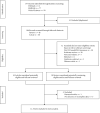Meta-Analysis of the Therapeutic Effects of Stem Cell-Derived Extracellular Vesicles in Rodent Models of Hemorrhagic Stroke
- PMID: 39263375
- PMCID: PMC11390234
- DOI: 10.1155/2024/3390446
Meta-Analysis of the Therapeutic Effects of Stem Cell-Derived Extracellular Vesicles in Rodent Models of Hemorrhagic Stroke
Abstract
Background: Stem cell-derived extracellular vesicles (SCEVs) have emerged as a potential therapy for hemorrhagic stroke. However, their effects are not fully understood. The aim of this study was to comprehensively evaluate the effects of SCEVs therapy in rodent models of hemorrhagic stroke, including subarachnoid hemorrhage (SAH) and intracerebral hemorrhage (ICH).
Materials and methods: We conducted a comprehensive search of PubMed, EMBASE, and Web of Science until May 2023 to identify studies investigating the effects of SCEVs therapy in rodent models of ICH. The functional outcomes were assessed using neurobehavioral scores. Standardized mean differences (SMDs) and confidence intervals (CIs) were calculated using a random-effects model. Three authors independently screened the articles based on inclusion and exclusion criteria. All statistical analyses were performed using Revman 5.3 and Stata 17.0.
Results: Twelve studies published between 2018 and 2023 met the inclusion criteria. Our results showed that SCEVs therapy improved neurobehavioral scores in the rodent SAH model (SMD = -3.49, 95% CI: -4.23 to -2.75; p < 0.001). Additionally, SCEVs therapy improved the chronic neurobehavioral scores of the rodent ICH model (SMD = 2.38, 95% CI: 0.36-4.40; p=0.02) but did not have a significant impact on neurobehavioral scores in the acute and subacute phases. Significant heterogeneity was observed among the studies, and further stratification and sensitivity analyses failed to identify the source of heterogeneity.
Conclusions: Our findings suggest that SCEVs therapy may improve neurofunctional behavior after hemorrhagic stroke and provide important insights into the design of preclinical trials.
Copyright © 2024 Conglin Wang et al.
Conflict of interest statement
The authors declare that they have no conflicts of interest.
Figures






Similar articles
-
Mesenchymal stem cells-derived therapies for subarachnoid hemorrhage in preclinical rodent models: a meta-analysis.Stem Cell Res Ther. 2022 Jan 29;13(1):42. doi: 10.1186/s13287-022-02725-2. Stem Cell Res Ther. 2022. PMID: 35093176 Free PMC article.
-
Therapeutic potential of stem cell extracellular vesicles for ischemic stroke in preclinical rodent models: a meta-analysis.Stem Cell Res Ther. 2023 Apr 3;14(1):62. doi: 10.1186/s13287-023-03270-2. Stem Cell Res Ther. 2023. PMID: 37013588 Free PMC article.
-
Extracellular vesicles for acute kidney injury in preclinical rodent models: a meta-analysis.Stem Cell Res Ther. 2020 Jan 3;11(1):11. doi: 10.1186/s13287-019-1530-4. Stem Cell Res Ther. 2020. PMID: 31900218 Free PMC article.
-
Association between Apolipoprotein E Polymorphism and Clinical Outcome after Ischemic Stroke, Intracerebral Hemorrhage, and Subarachnoid Hemorrhage.Cerebrovasc Dis. 2022;51(3):313-322. doi: 10.1159/000520053. Epub 2021 Dec 15. Cerebrovasc Dis. 2022. PMID: 34915479
-
Resveratrol has an Overall Neuroprotective Role in Ischemic Stroke: A Meta-Analysis in Rodents.Front Pharmacol. 2021 Dec 20;12:795409. doi: 10.3389/fphar.2021.795409. eCollection 2021. Front Pharmacol. 2021. PMID: 34987407 Free PMC article. Review.
References
-
- Duan S., Wang F., Cao J., Wang C. Exosomes derived from MicroRNA-146a-5p-enriched bone marrow mesenchymal stem cells alleviate intracerebral hemorrhage by inhibiting neuronal apoptosis and microglial M1 polarization. Drug Design, Development and Therapy . 2020;14:3143–3158. doi: 10.2147/DDDT.S255828. - DOI - PMC - PubMed
Publication types
LinkOut - more resources
Full Text Sources
Miscellaneous

